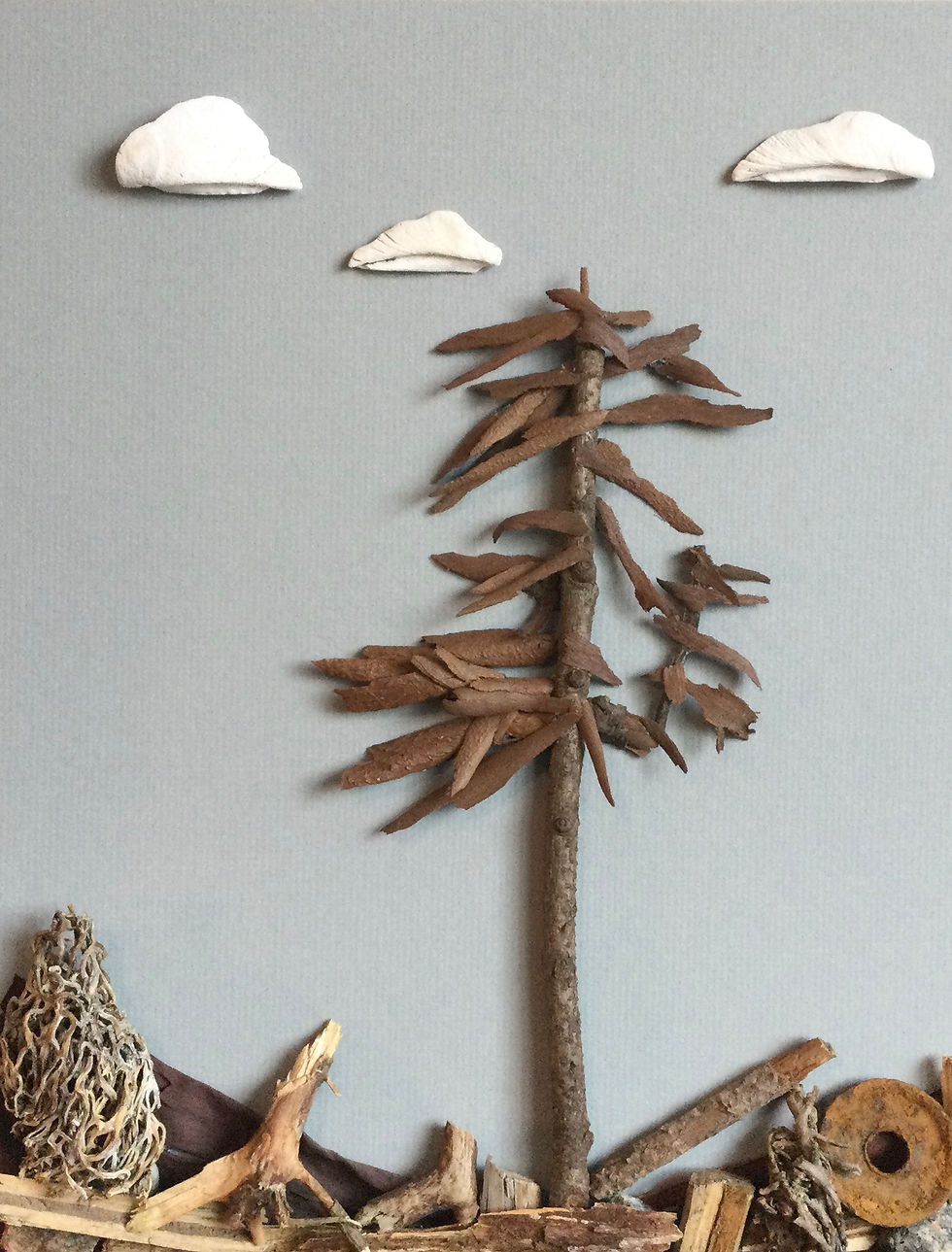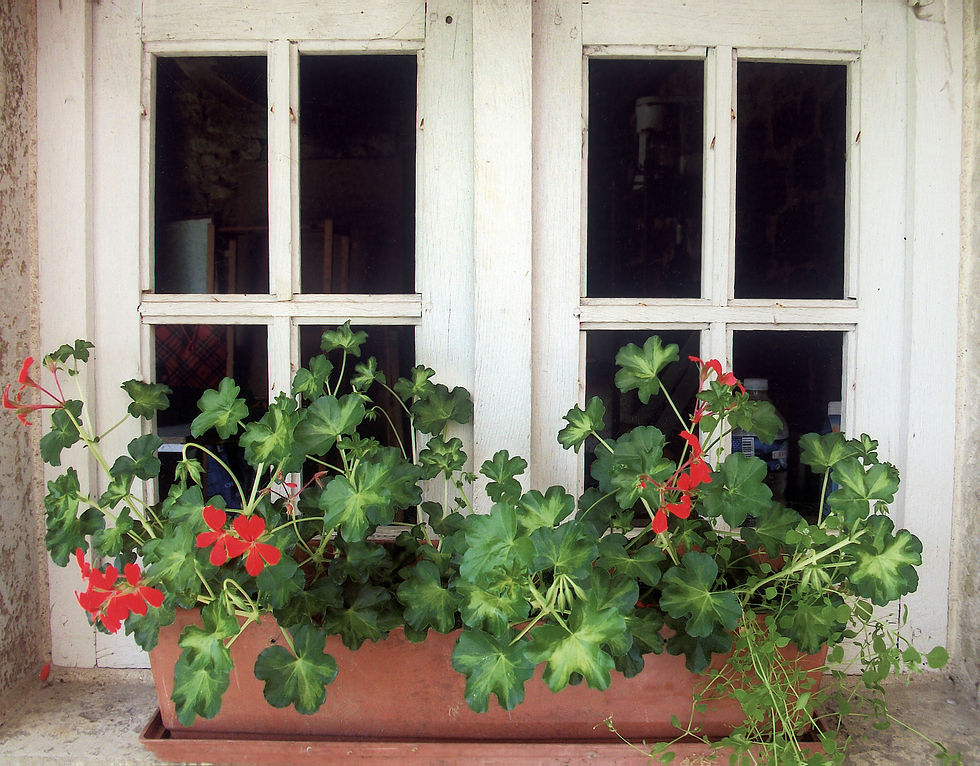About Trouve Of A Kind
Trouve - French for find
In 2019, Trouve Of A Kind was founded by Elizabeth Ashworth, an artist who combines her interests in mixed-media art and the environment. She creates works using not only objects found in nature but also those discarded by people. Her other passion is photography, especially taking images inspired by Nature.
Each work is unique.

Gallery I : Mixed-Media Works
My favourite finds for making art are Arbutus bark and beach items. Arbutus (aka Madrona or 'strawberry') trees are plentiful along the Pacific Coast of North America. They are evergreens that keep their broad leaves and shed their bark. The bark's coppery colour is two-toned (dark on the outside, light on the inside) and its thickness can range from 'tissue paper' to 'cardboard'. Arbutus trees are protected in British Columbia so I collect the bark (from the ground, not the tree) when it is shed in August. I often start a work with the bark to create background hills, islands, and wave, then I add beach items (driftwood, shells, stones, etc) to create a representative image. Please click on each image for a closer look. * denotes sold works


This was my second large work using arbutus bark. The shadow box frame came with a black velvet background so that inspired me to do a nightscape. I had more difficulty finding the right stone on a nearby beach to represent the moon than I did finding curled bark to resemble waves. The driftwood pieces in the foreground were also found locally and are arranged similarly to how logs rest on the beach after a storm.

This was my first large work using arbutus bark. After experimenting with flat and curled pieces of bark in smaller works, I felt motivated to work on a larger scale. This image was inspired by the view from Sooke, across the Salish Sea, towards the Olympic Mountains in Washington State.

Every winter, the west coast of Vancouver Island gets hit by storms and floating logs are catapulted by waves onto the shore. A good place to see these 'thrown' logs is French Beach, northwest of Sooke. When you stand on the Juan de Luca trail, and look across the strait towards Washington State, it is hard to not only see the beach for the logs but also climb over them to get to the beach.

This mixed-media piece was inspired by the steep slopes leading down to many west coast beaches: littered with driftwood, fallen rocks, wind-blown trees.

I collect perfectly round stones from a beach near my home, and one inspired this representation of a west coast beach at night.

This piece began after a walk along Ella Beach, near Sooke. There is a large kelp forest just off shore and, during winter storms, the kelp stipes and bulbs are thrown far up the beach. By summer, they are dry and hard: perfect for creating a mixed media work. This image represents an underwater view of kelp, attached to the seabed rocks, dancing in the ocean currents.

This triptych echoes views around the Salish Sea and all items used to create it were found on beaches beside that body of water: arbutus bark, driftwood, stones, string, etc. The arbutus bark is great for representing mountains, beaches, waves, and tree limbs. The tree represented here is a Douglas Fir, often seen standing tall and strong near the Salish Sea.

I had the privilege to travel out to Big Lonely Doug in October 2019. After a long drive, and difficult hike around logging debris (echoed in the items at the bottom of this piece), I was able to meet, and hug, this iconic Douglas Fir. For many, 'his' story inspires what can be done to preserve old growth forests in BC and elsewhere, hence the title of this work.

I love whales and was inspired by aerial footage of humpbacks creating a 'bubble net' of air to corral food. To me, tumbled mussel shells resembled heads and fins of humpbacks so they were a natural fit for this diorama.
Gallery II : Digital Photographs on Canvas
The locations for these photographs were 'finds' during my travels. For many years, my research work took me to six continents where I overcame jet lag by walking and taking photos. When I was home, I explored remote places on foot and by canoe. Each photograph is printed on 100% cotton canvas using a giclee process and stretched over a wood frame. Please click on each image for a closer look. * denotes sold works

I took this photograph in the village of Saint-Thibault, Burgundy, France, which is dominated by its priory/church of the same name. I expected the interior of the church to be filled with ornate decoration and was surprised by how plain it was: it made me think of how Gothic cathedrals may have looked when they were first built. Its simplicity helped me appreciate the architecture more because it was more visible.

This photograph was taken during a hike to Witty’s Lagoon, near Victoria. Along the beach trail are several arbutus trees, covered with ‘old man’s beard’ (aka beard lichen). I liked how the lichen helped to soften the sunlight as it shone through the limbs of the tree.

I took this photograph during a trip to Burgundy, France. While exploring a small village, and enjoying its 18th-century appearance, I was bothered to see plastic water bottles and other modern ‘inconveniences�’ behind the charming window of a curbside house. To me, the window box and its flowers were trying to improve the view, from inside and outside.

For many years, I participated in canoe trips with friends, and this photograph was taken at Sawyer Lake, in Algonquin Park, Ontario, during one of them. We had just set up camp after paddling in wind all day. The lake was finally calm at sunset and became a beautiful mirror of the evening sky with its rising moon.

This photograph was taken during a canoe trip in Killarney Provincial Park, Ontario. The location was a campsite on Bell Lake and the late afternoon sun was obscured by clouds. I like how the tree silhouettes frame this monochromatic sunset.

This photograph is a companion piece to Almost Heaven as it was taken in the same church in Saint-Thibault, Burgundy, France. This sculpture/gargoyle was placed, unusually, at eye level above the baptismal font. The ‘happy’ character seemed to hover, watching the viewer access the water in the font.

My favourite place to visit in New York City is the Metropolitan Museum of Art. This photograph was taken in the Sackler Wing of the museum, beside the Temple of Dendur. It was like being in a little piece of warm Egypt on a cold New York day. I liked how the hard, straight window mullions were reflected as soft, curving lines in the temple pool.

I took this photograph in 2000 and rediscovered it years later. On a rough evening cruise, I had struggled to get a clear shot of the buildings. This struggle, however, helped to create zig zag light effects, making it more like a softened ‘memoryscape’ than a hard cityscape. In light of the events of the following year, I think it portrays a colourful, positive memory of downtown Manhattan.
Gallery III: Other Digital Photographs
These photographs were taken during travels in British Columbia and Ontario. All are available for sale, in various sizes and on various surfaces (paper, canvas, foam core, etc). Prices are available on request. Please click on each image for a closer look.

China Beach, in Juan de Fuca Provincial Park, is known for its scenic forest path, sandstone walls, and calm waters. This photograph, however, was taken on a bleak January day when that beach was uninviting. I was drawn to this tree, and understood its struggle to stay upright, like me, on that stormy, Pacific winter day.

This photograph was taken at the Sooke wharf after a whale watching trip. Although I had just seen humpback whales at a distance, I enjoyed meeting these seals in a more intimate way. I am new to coast living and it was the first time I had been this close to seals. I’m not sure who was more curious: me looking at them, or one looking at me…likely both!

This image was taken at Botany Bay, near Botanical Beach, Port Renfrew. The photograph reflects the gloomy, January day it was taken, and this mood helped it to win a place in the Vancouver Island Symphony's 'Pictures Project'. It was chosen to represent the 'Old Castle' segment of the VIS's April 2022 presentation of Mussorgsky's "Pictures at an Exhibition".

This image was taken during a canoe trip around Philip Edward Island, Lake Huron, Ontario. Our group had parked our canoes on a point of land on the southeast part of the island. It was covered with pink granite boulders, scoured thousands of years ago during the last ice age. The rocks were even more interesting because of the lichen shapes that decorated them. These shapes looked like alien language or natural graffiti.

This photograph was taken on a foggy August afternoon, at Long Beach, Pacific Rim National Park, Vancouver Island. At first, I was disappointed that I could see little of the Pacific Ocean, but the presence of the fog helped emphasize the waves, the sand, and the bull kelp that had washed up on the beach.

It's always good to look down once in a while. While hiking, I looked at my feet and appreciated the variety of textures in the rocky landscape, especially a tree that was doing its best to hang on to the land.
Gallery IV: Commissioned Work



Spirit of the Salish Sea, 2020 (triptych - 92 x 14) *
This work was commissioned by patrons who wanted a large piece to compliment two of my mixed-media landscapes in their collection. When they gave me the dimensions, I was inspired to create a broad scene that not only included elements of their two landscapes but also looked as if it was one scene viewed through three windows. Although the landscape echoes views around the Salish Sea, it is not of a specific place. I found all items for the piece in areas beside that body of water.

Night Rollers III, 2022 (9 x 20) *
My patron for this mixed media work wanted something similar to my first Night Rollers piece. Like its predecessor, this work includes found materials from local areas: arbutus bark, driftwood, and beach stones. They were all glued on to a velvet background to give more depth to the 'night' theme. The most difficult part of creating this work was finding the 'right' stone to represent a moon. To find one, I went to Ella Beach, near Sooke, because of its abundance of rounded stones: found one there within minutes!

Scavenger, 2022 (8 x 10) *
This work was inspired by Corvus Corax (2020) and depicts a crow deconstructing a salmon. The crow is made from arbutus bark, kelp stipes, and a push pin, along with salmon bones and wood found on a local beach. It was created for a patron who has a collection of art depicting crows and ravens.

Bubble Net Buddies II, 2025 (10 x 10) *
A friend asked me to create this work after he saw Bubble Net Buddies on my web site. It was a gift for his girlfriend who loves whales. I enjoy seeing drone footage of humpback whales creating bubble nets to contain their prey, and collect surf-tumbled mussel shells because their tones and shapes resemble them. I also used old quilt batting and hot glue to represent the spray from their movements.
